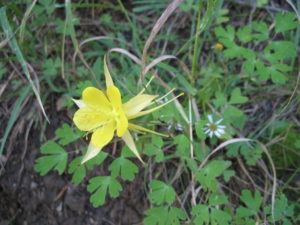
Golden Columbine (Aquilegia chrysantha)
When taking a class related to botany, usually one of the biggest factors that follows is the obligation to put together a plant journal. This is a way for natural historians to keep a record of what species are (or were) present in a particular region at a given time. Therefore, in addition to collecting the actual plants themselves, it is absolutely imperative to gather as much data as possible regarding the date and time of collection, weather, temperature, geography of the site (both general and more precise), soil texture, flower color (the color often fades soon after uprooting), plant size (length, width, and height), smell, distribution, association with other species, specific location (ex. how many meters away from the main road? In what direction?), and any other observations that seem worth noting (i.e. does the plant appear sick? Any abnormal features present?). Taking a picture is never a bad idea. Additionally, utilizing GPS coordinates is a good way to document an area; this will also help in being able to describe the exact spot you were at using Google Earth (be aware nonetheless that its accuracy can falter at times). Though the minute details may seem insignificant at the moment, they may (and likely will) come in handy later when future studies are conducted of current and past ecological relationships in the region. I personally gathered my 4 assigned plants in the fall of 2016 primarily at Molino Basin and Bear Wallow on Mt. Lemmon north of the Tucson Valley, though various campgrounds up along the highway and washes all around town were prime locations too. Moreover, each plant had to be from a different family, we were only permitted to collect native species, and my classmates and I were prohibited from picking particular plants that are common all around the city.
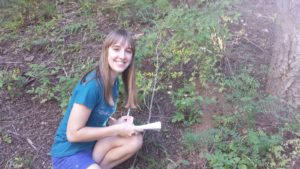
Collecting Data
While gathering samples, as many different features of the plant (leaves, flowers, fruits, seeds) should be included as possible; this will help in identification later. Smaller specimens ought be torn up by the roots, and larger organisms (such as trees and bushes) should be thoroughly described prior to cutting off a branch (it is preferable to cut instead of tear as this will help prevent exposing the tree to possible infection). Once this is done and the species has been collected, a plant press will be needed. This is a very basic structure consisting of two pieces of plywood with one to two layers of newspaper in the middle; some botanists add a layer of cardboard between the wood and paper and also tie a belt around the entire thing to keep it together. If the particular organism you are pressing is very moist and “juicy” (i.e. a succulent), more layers of newspaper will be better. Additionally, I highly advise assigning each plant a number and writing this down both on the paper and the specimen’s relevant entry in your field notebook. This is useful in order to remember later which recorded data corresponds with which species. The plant may then be positioned within two folds of newspaper (to create a “sandwich”) in such a way that critical parts needed in identification will be clearly visible after the organism is completely flat. Finally, the two pieces of plywood can be used to start pressing; it is recommended to stand on the structure for a minute or two to begin the process while still out in the field.
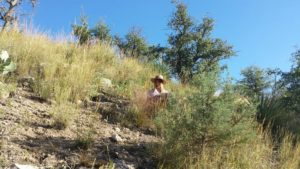
Collecting (More) Data
As more species are collected, the layers of newspaper can simply be stacked on top of one another between the two pieces of plywood. Once at home, several heavy books should be placed on top of the press. Additionally, it is a good idea to change the paper once every one to two days for the first week to prevent mold from growing (again, especially for the more succulent species). After all the plants are completely dry and flat, they may be glued to card stock sheets or carefully broken up into smaller pieces if the sample is rather large. A label, such as on an index card or printed out, will then be added that contains all the data you recorded, with the family, scientific name, and authority (person who originally named the plant) at the top and the date, collector’s name, and specimen number at the bottom. It can be glued to the back of the sheet if there isn’t room in front. Moreover, any extra, loose parts (i.e. seeds, fruits) may either be glued or placed into a small “envelope” that will also be attached to the card stock; things like pine cones should be placed into a labeled box to be stored separately. Each sheet will then be slipped into a translucent file folder. Finally, these will be arranged alphabetically in a binder by family name. If more than one plant belongs to the same family, go by genus and eventually species.
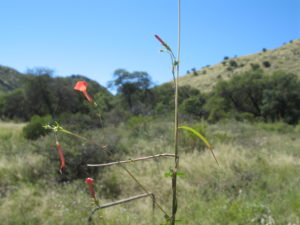
Scarlet Morning-Glory (Ipomoea cristulata)
Below you can see a sample label. It’s not perfect, and some things could probably have been a little more specific (such as adding weather, temperature, and time of collection). However, for this purpose here it will do.
RNR 230L Plant Collection
Fall 2016
Family: Asteraceae
Species: Dieteria asteroides Torr.
Collection Location: Pima Co., AZ. From the intersection of Catalina Hwy. and Tanque Verde Rd., head 6.8 km up Catalina Hwy. to the Forest boundary (where it becomes Hitchcock Hwy.). An additional 9 km from there. Turn west. 68 m SWW of the entrance to Molino Basin Campground. An additional 12.7 m NW from that point (next to a group of five parking spots; located on the southern end of the last spot). Latitude: 32°20’14.52”N, Longitude: -110°41’28.64”W. Elevation: 1329 m a.s.l. (Lat., long. and elev. estimates based on analysis of Google Earth image, 3 November 2016).
Habitat: Grassland environment including trees and shrubs. On SE-facing slope of wash approx. 1 to 2 m wide. Dead leaf matter and compost create a matted look on top of soil. Numerous stolons growing around base of plant from surrounding grasses.
Description: Part of plant collected. Plant approx. 1 m tall. In full flower with several mature achenes. No discoloration in dried specimen. Widespread throughout range at numerous locations on the campground.
Date: 17 September 2016
Collector: S. Slovikosky
Specimen #1
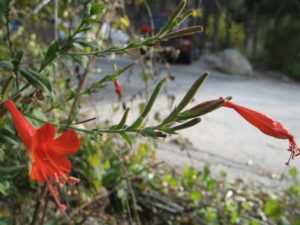
Hummingbird Trumpet (Epilobium canum)
Finally, I wanted to mention here a couple tips for identification purposes. First and foremost, it is important to be aware that different sunflower species of the family Asteraceae can look very similar. Thus, great care should be taken when looking these up. Additionally, some species’ Latin and family names have changed in the past. To verify that the ones you write on your label are the most current ones, look them up on ITIS.gov. This website will inform you if they are “accepted” or not, and will mention the accepted names if the entered Latin ones are out of date. Further, for other identification purposes, two websites I recommend for plants in Arizona are swbiodiversity.org and fireflyforest.com. Moreover, there are many books and field guides available for purchase (I primarily used Wildflowers of Arizona by Nora and Rick Bowers and Stan Tekiela, and Madera Canyon Wildflowers by Joan W. G. Lewis). Heading over to a university herbarium where mass collections of plants are stored over the years will also get you in touch with knowledgeable staff who can help.
Note: Although I only had to gather 4 plants, I ended up with over 60 and prepared labels for 21 of them. The document with these is attached below.
Additionally, here is a dichotomous key I created for all 30 plant families that were studied in this lab. Techniques for identification included examining key vegetative and reproductive structures, as well as noting locations in which the specimens were found.